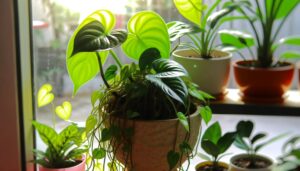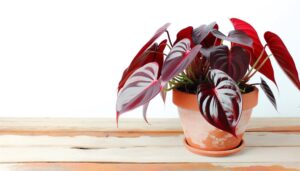How Do You Care for Philodendron Moonlight? Complete Guide!
To care for Philodendron Moonlight, aim to replicate its natural humid, South American climate by maintaining temperatures between 65-78°F and humidity levels above 50%. Provide bright, indirect light and keep soil moderately moist, watering once the top inch dries.
Fertilize periodically with a balanced (20-20-20) solution and prune as needed for shape and health. To manage pests and diseases, enact prompt treatment and guarantee proper drainage.
If interested, propagate the plant by placing a healthy stem cutting in water for root development. Unearth further plant care secrets for Philodendron Moonlight with continued exploration.
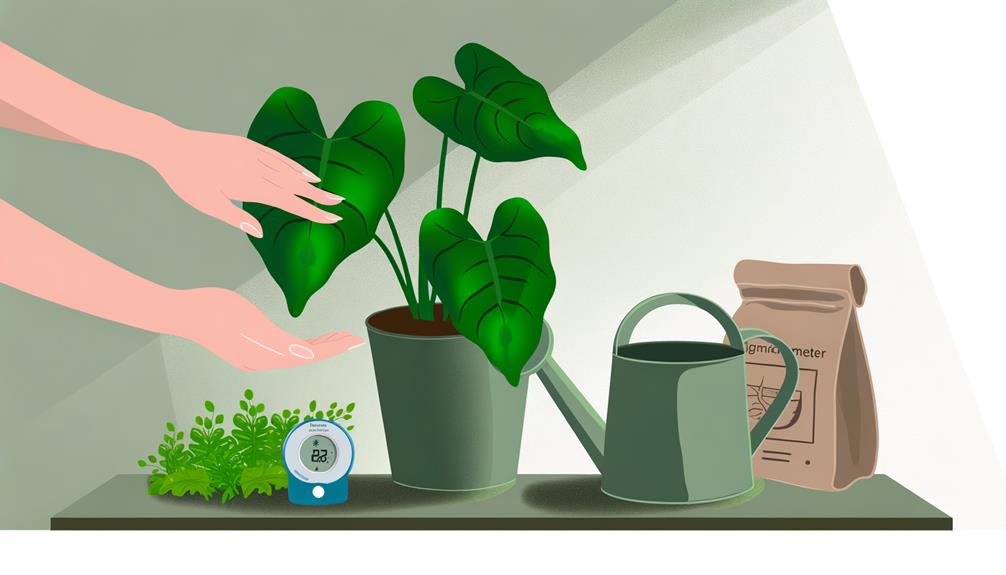
Key Takeaways
- Provide Philodendron Moonlight with bright, indirect light, avoiding direct sunlight.
- Keep the soil moderately moist, watering when the top inch is dry.
- Maintain temperature within 65-78°F (18-25°C) and humidity levels above 50%.
- Use a balanced (20-20-20) fertilizer in spring and summer, avoiding over-fertilization.
- Regularly prune the plant, remove affected leaves promptly, and treat pests with insecticidal soap or neem oil.
Understanding Philodendron Moonlight Characteristics
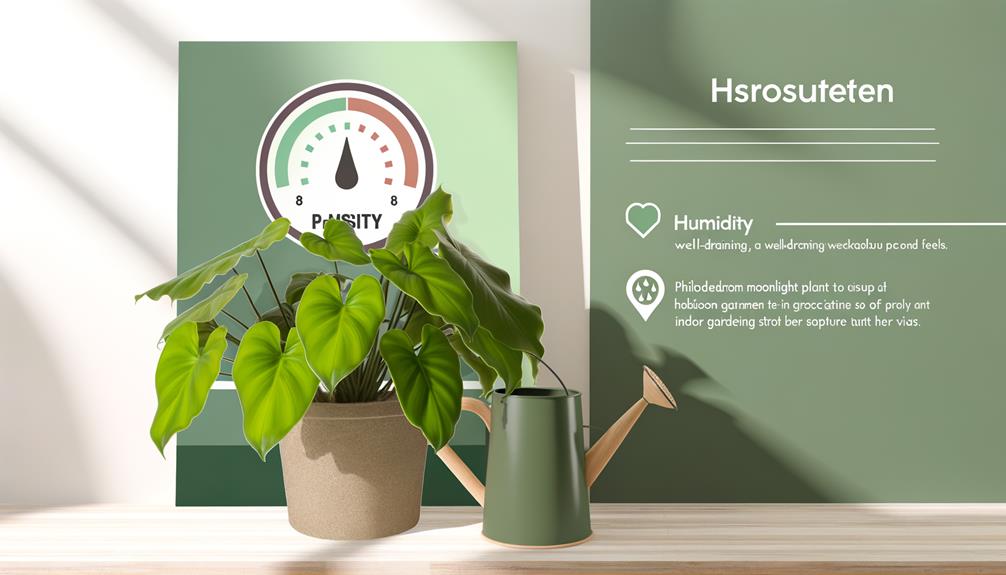
The Philodendron Moonlight‘s distinct features, marked by its vibrant lime-green foliage and compact growth pattern, provide a mesmerizing spectacle that enhances any indoor plant collection.
This tropical variety, hailing from the rainforests of South America, possesses an innate resilience that makes it a favorite among plant lovers. Its compact growth habit allows it to fit comfortably in small spaces, making it an ideal choice for urban dwellers with limited space.
The plant’s leaves unfurl in a light green color, gradually darkening as they mature. From a care perspective, the Philodendron Moonlight requires moderate light and well-draining soil to thrive.
These robust characteristics combined with the plant’s visually striking appearance make it a worthy addition to any indoor garden endeavor.
Ideal Temperature and Humidity Levels
The Philodendron Moonlight, like many tropical plants, thrives in specific temperature and humidity ranges. Understanding and maintaining this ideal environment is essential for the plant’s health and vitality.
As a result, we will explore the significance of these conditions and discuss strategies to avoid their extremes, guaranteeing your Philodendron Moonlight flourishes.
Maintaining Optimal Temperature
Ensuring a stable climate, with temperatures between 65-78°F (18-25°C) and humidity levels above 50%, fosters the lush growth of Philodendron Moonlight. However, this tropical plant is also resilient and can tolerate a certain degree of temperature fluctuations. For best results, maintaining the right balance is key.
Here’s a useful table to guide you:
| Temperature Range (°F) | Temperature Range (°C) | Humidity Level (%) |
|---|---|---|
| 65-70 | 18-21 | 50-60 |
| 70-75 | 21-24 | 60-70 |
| 75-78 | 24-25 | 70-80 |
Importance of Humidity
In the world of indoor gardening, humidity levels play an integral role, especially for tropical plants like Philodendron Moonlight, which thrive in conditions that mimic their natural, moisture-rich habitats.
Maintaining a humidity level of around 65-75% is ideal for the lush growth of this plant. Low humidity can lead to browning leaf tips and slow growth, whereas excessive humidity may invite fungal diseases. To achieve this, you can use a simple humidity tray, a room humidifier, or regularly mist the plant with water.
Monitoring humidity levels with a hygrometer can help provide the best care for your Philodendron Moonlight. By maintaining the right humidity, you can ensure the health and vibrancy of your plant, and serve as a responsible steward of nature’s beauty.
Avoiding Extreme Conditions
While maintaining ideal humidity for your Philodendron Moonlight is important, it’s equally significant to keep the plant away from extreme temperature conditions for its overall well-being. Philodendron Moonlight thrives best in temperatures between 60-75°F (15-24°C) and humidity levels of 65-75%.
Below is a table that provides a snapshot of the ideal conditions for your cherished Philodendron Moonlight:
| Temperature (°F) | Temperature (°C) | Humidity (%) |
|---|---|---|
| 60 | 15 | 65 |
| 65 | 18 | 70 |
| 70 | 21 | 75 |
| 75 | 24 | 70 |
| 60 | 15 | 65 |
Extreme temperatures and humidity can lead to leaf drop, making it imperative to avoid such conditions for a healthy, vibrant Philodendron Moonlight.
Importance of Proper Lighting
Bathing your Philodendron Moonlight in the right amount of light is crucial, as it greatly impacts the plant’s growth and well-being. Proper lighting conditions can make a significant difference, influencing the plant’s overall health and appearance.
Consider the following points to guarantee your Philodendron Moonlight receives the right amount of light:
- Position your plant in a location with bright, indirect light. Direct sunlight could harm the leaves.
- Rotate your plant periodically to make sure all sides get equal exposure.
- If indoors, place near a north or east-facing window.
- Monitor the plant’s color. Vibrant green leaves indicate adequate lighting.
Watering Your Philodendron Moonlight
Just as lighting plays an essential role in the health of your Philodendron Moonlight, maintaining the appropriate watering schedule is equally significant for the plant’s strength and growth.
This tropical plant prefers a balance, neither being too wet nor too dry. Over-watering can lead to root rot, while under-watering can cause wilting. The soil should be kept moderately moist. A good rule of thumb is to water this plant when the top inch of soil has dried out.
This usually equates to watering once a week, but will depend on the humidity and temperature of your environment. In the cooler months, watering may be reduced as the plant’s growth slows.
Fertilizing Philodendron Moonlight

To guarantee the strong growth and vivid color of your Philodendron Moonlight, a thorough understanding of its fertilizer requirements is crucial.
This involves not only choosing the correct type of fertilizer but also following a suitable fertilizing schedule and procedure.
Let us now delve into these crucial aspects that can greatly improve the health and beauty of your Philodendron Moonlight.
Understanding Fertilizer Needs
In the field of best plant health, understanding the fertilizer needs of the Philodendron Moonlight is essential, as this particular species thrives on specific nutrients found in certain types of fertilizers. These nutrients not only promote plant growth but also enhance the vibrant coloration of the leaves, an attribute highly sought after by plant enthusiasts.
Consider the following key points about Philodendron Moonlight’s fertilizer needs:
- The plant flourishes with a balanced (20-20-20) fertilizer formulation.
- It appreciates regular feeding during the growing season (spring and summer).
- Over-fertilization can lead to leaf burn, so moderation is important.
- Winter feeding should be reduced as the plant enters a semi-dormant state.
Understanding these needs will help you provide ideal care for your Philodendron Moonlight.
Choosing the Right Fertilizer
Regularly selecting the suitable fertilizer for your Philodendron Moonlight is an essential aspect of plant care that requires both knowledge and attention to detail. This tropical plant thrives with a balanced houseplant fertilizer, preferably with a 20-20-20 ratio of nitrogen, phosphorous, and potassium.
The right fertilizer not only enriches the plant’s immediate environment but also supports vigorous growth and radiant foliage. Avoid fertilizers heavy on ammonium nitrate, which can harm the roots. Organic alternatives, such as worm compost or seaweed emulsion, can also be beneficial.
The pH level of the fertilizer should be between 5.5 and 6.0, ideal for Philodendron absorption. Remember, the goal is to nourish your Philodendron Moonlight, enhancing its health while also displaying your dedication to its well-being.
Fertilizing Schedule & Procedure
Establishing an effective fertilizing schedule for your Philodendron Moonlight is crucial to access its full growth potential and maintain its vibrant foliage. A consistent and balanced approach to fertilization can ensure this houseplant thrives.
Here are some guidelines:
- Fertilize during the growing season (spring and summer) for best results.
- Use a balanced, water-soluble fertilizer at half strength every month.
- Always water your plant before applying the fertilizer to prevent root burn.
- In winter, reduce the frequency as the plant’s growth slows down.
Through this approach, you are not only providing your Philodendron Moonlight with the nutrients it needs, but also demonstrating a commitment to its long-term health and well-being.
Repotting Your Plant Correctly
The successful repotting of your Philodendron Moonlight hinges on a few key preparatory steps, ensuring the plant’s vibrant growth and longevity.
Begin by carefully loosening the soil around the plant’s root system. Select a new pot that is roughly 2 inches larger in diameter than the current one, ensuring sufficient room for growth. Remember to use a high-quality, well-draining potting mix for best results.
Place the Philodendron Moonlight in the new pot, gently spreading its roots. Add more potting mix, pressing lightly around the base of the plant for stability. Water thoroughly after repotting, making sure not to oversaturate.
These careful actions foster a nurturing environment for your Philodendron Moonlight, promoting its flourishing future.
Pruning and Maintenance Tips
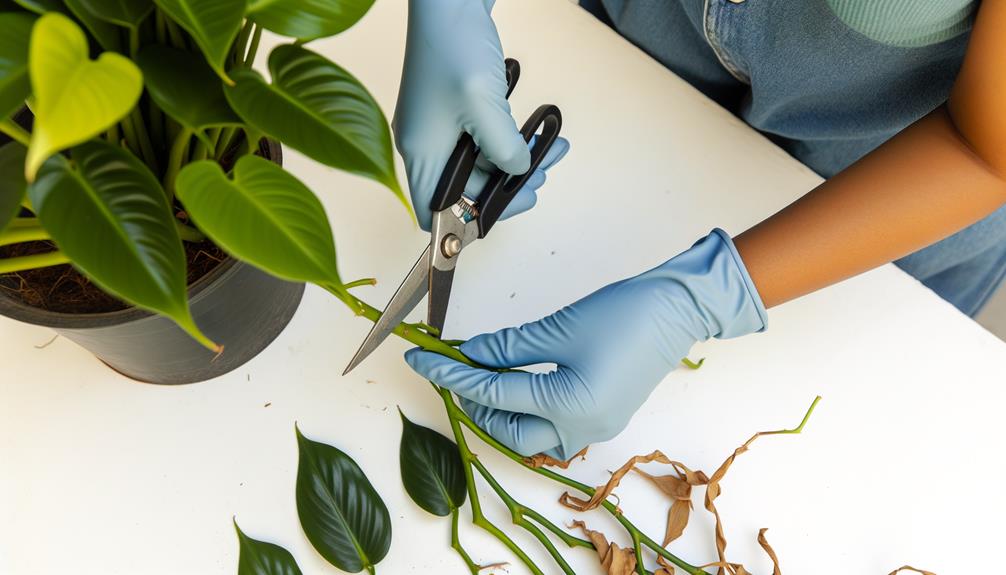
Maintaining a Philodendron Moonlight’s health and vibrancy involves a keen understanding of regular pruning techniques and routine care. The plant’s longevity relies heavily on meticulous maintenance, which includes the detection and resolution of common issues.
As we proceed, we will highlight the most effective strategies to keep your Philodendron Moonlight thriving.
Regular Pruning Techniques
Regular trimming of your Philodendron Moonlight not only supports a fuller appearance but also aids in preserving the overall health of the plant. The process, if done correctly, helps in prolonging the lifespan and vibrancy of your plant.
Here are some techniques to keep in mind:
- Always use clean, sharp tools to avoid disease transmission and guarantee a clean cut.
- Prune during the growing season, typically spring to early summer.
- Cut off yellowing or browning leaves close to the base to allow for new growth.
- Finally, remove any excess growth that overshadows the plant’s center to ensure even light distribution.
These steps, when undertaken with care and passion, will maintain the aesthetic appeal and health of your Philodendron Moonlight, contributing to its overall wellbeing.
Philodendron Moonlight Maintenance
In the domain of Philodendron Moonlight care, effective maintenance goes beyond regular pruning it encompasses a holistic approach that includes ideal watering, appropriate fertilization, and vigilance against pests and diseases.
The plant thrives in moist, well-drained soil; overwatering can lead to root rot. Fertilize it monthly during the growing season with a balanced, water-soluble fertilizer for best results.
Regularly inspect your Philodendron Moonlight for signs of pests like aphids, mealybugs, or spider mites, and promptly treat any infestations. Prune the plant to maintain its shape and remove any yellow or brown leaves to keep it healthy.
With these maintenance practices, your Philodendron Moonlight will flourish, showcasing its lush, bright green foliage.
Dealing With Common Issues
Getting through the common issues associated with Philodendron Moonlight can seem challenging, but the right pruning and maintenance strategies can help keep your plant healthy and vibrant.
- Pruning: Regular pruning helps control the size of your plant and promotes bushier growth. Cut off any yellow or brown leaves as they appear.
- Watering: Overwatering is a common mistake. Water the plant only when the top inch of soil is dry.
- Lighting: The Philodendron Moonlight prefers bright, indirect light. Avoid placing it in direct sunlight to prevent leaf burn.
- Pest Control: Occasionally, the plant may attract pests like aphids and spider mites. Use a mild insecticidal soap or neem oil to control these pests.
Managing Pests and Diseases
Managing pests and diseases is an essential aspect of caring for your Philodendron Moonlight, especially given the plant’s vulnerability to certain insects and fungal infections. It’s pivotal to regularly monitor your plant for signs of infestation such as discolored leaves or a sticky substance on the plant or surrounding areas, which could indicate the presence of aphids or mealybugs.
For treatment, insecticidal soap or neem oil can be effective. Fungal diseases, often resulting from overwatering or poor ventilation, can be prevented by ensuring your plant has adequate drainage and air circulation. If you notice any fungus, promptly remove the affected leaves and consider using a fungicide.
Ultimately, diligent observation and prompt action can keep your Philodendron Moonlight healthy and vibrant.
Recognizing Common Philodendron Problems
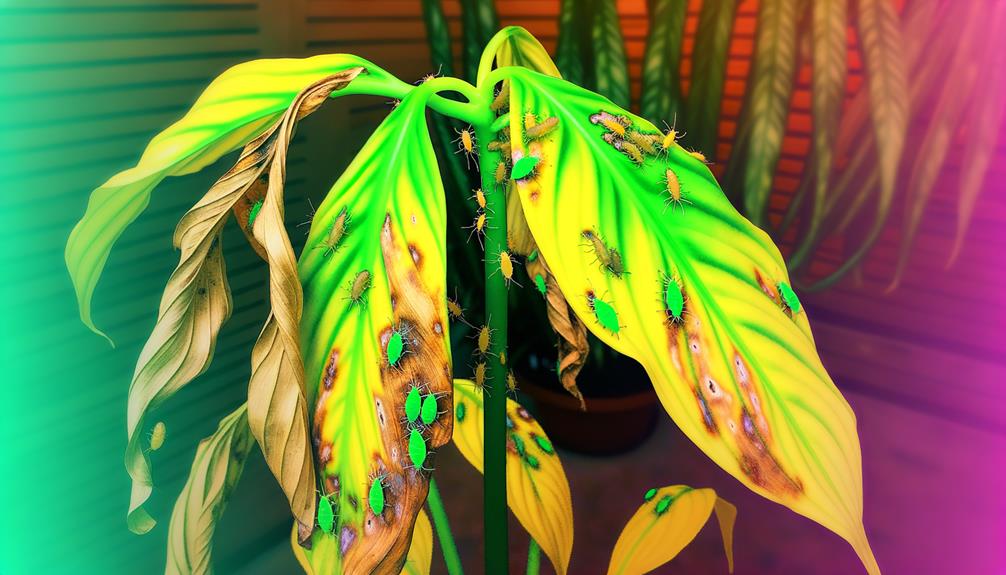
While caring for your Philodendron Moonlight, it’s vital to be able to identify common plant problems, as early recognition can greatly improve the effectiveness of your intervention strategies.
This lush and vibrant plant can occasionally face challenges, which can be managed effectively if identified promptly.
Here are four key issues to watch for:
- Yellow Leaves: Overwatering is often the cause. Make sure your watering routine aligns with the plant’s needs.
- Brown Spots: Usually a sign of a bacterial or fungal infection. Prompt treatment is important.
- Wilted Leaves: Could indicate underwatering, or a need for repotting.
- Pest Infestation: Spider mites, mealybugs, and aphids can cause significant harm.
Propagating Your Philodendron Moonlight
Should you desire to multiply the beauty of your Philodendron Moonlight, propagation is an effective and gratifying method to achieve this aim. Start by selecting a healthy stem with at least two nodes and cut it just below the second node.
Place this cutting in water, ensuring the nodes are submerged but leaves remain above water. Provide it with ample indirect sunlight and patiently wait for roots to develop. Once roots are visible, you can plant the cutting in a well-draining soil mix, similar to the parent plant’s environment.
Conclusion
To sum up, the Philodendron Moonlight’s care is a delicate balance of ideal humidity, suitable lighting, prudent watering, regular fertilization, careful pruning, and vigilant pest and disease management. Its successful cultivation is akin to conducting a symphony, where each element harmoniously contributes to the plant’s overall health.
Understanding common Philodendron problems and mastering propagation techniques can further enhance the beauty and longevity of this luminescent foliage, making it a vibrant addition to any indoor garden.




